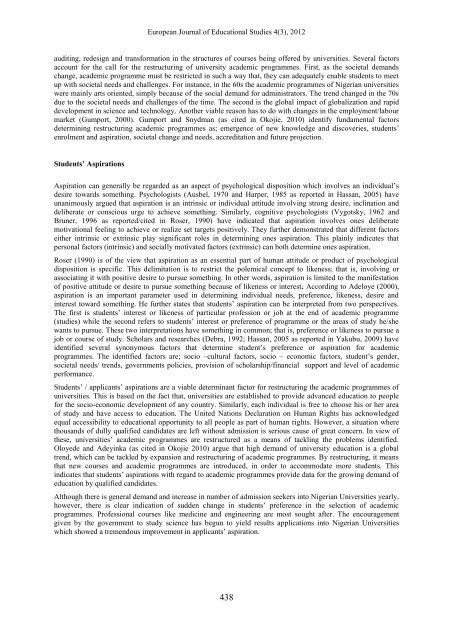Volume 4 Issue 3 (October 2012) - Ozean Publications
Volume 4 Issue 3 (October 2012) - Ozean Publications
Volume 4 Issue 3 (October 2012) - Ozean Publications
You also want an ePaper? Increase the reach of your titles
YUMPU automatically turns print PDFs into web optimized ePapers that Google loves.
European Journal of Educational Studies 4(3), <strong>2012</strong><br />
auditing, redesign and transformation in the structures of courses being offered by universities. Several factors<br />
account for the call for the restructuring of university academic programmes. First, as the societal demands<br />
change, academic programme must be restricted in such a way that, they can adequately enable students to meet<br />
up with societal needs and challenges. For instance, in the 60s the academic programmes of Nigerian universities<br />
were mainly arts oriented, simply because of the social demand for administrators. The trend changed in the 70s<br />
due to the societal needs and challenges of the time. The second is the global impact of globalization and rapid<br />
development in science and technology. Another viable reason has to do with changes in the employment/labour<br />
market (Gumport, 2000). Gumport and Snydman (as cited in Okojie, 2010) identify fundamental factors<br />
determining restructuring academic programmes as; emergence of new knowledge and discoveries, students’<br />
enrolment and aspiration, societal change and needs, accreditation and future projection.<br />
Students’ Aspirations<br />
Aspiration can generally be regarded as an aspect of psychological disposition which involves an individual’s<br />
desire towards something. Psychologists (Ausbel, 1970 and Harper, 1985 as reported in Hassan, 2005) have<br />
unanimously argued that aspiration is an intrinsic or individual attitude involving strong desire, inclination and<br />
deliberate or conscious urge to achieve something. Similarly, cognitive psychologists (Vygotsky, 1962 and<br />
Bruner, 1996 as reported/cited in Roser, 1990) have indicated that aspiration involves ones deliberate<br />
motivational feeling to achieve or realize set targets positively. They further demonstrated that different factors<br />
either intrinsic or extrinsic play significant roles in determining ones aspiration. This plainly indicates that<br />
personal factors (intrinsic) and socially motivated factors (extrinsic) can both determine ones aspiration.<br />
Roser (1990) is of the view that aspiration as an essential part of human attitude or product of psychological<br />
disposition is specific. This delimitation is to restrict the polemical concept to likeness; that is, involving or<br />
associating it with positive desire to pursue something. In other words, aspiration is limited to the manifestation<br />
of positive attitude or desire to pursue something because of likeness or interest. According to Adeloye (2000),<br />
aspiration is an important parameter used in determining individual needs, preference, likeness, desire and<br />
interest toward something. He further states that students’ aspiration can be interpreted from two perspectives.<br />
The first is students’ interest or likeness of particular profession or job at the end of academic programme<br />
(studies) while the second refers to students’ interest or preference of programme or the areas of study he/she<br />
wants to pursue. These two interpretations have something in common; that is, preference or likeness to pursue a<br />
job or course of study. Scholars and researches (Debra, 1992; Hassan, 2005 as reported in Yakubu, 2009) have<br />
identified several synonymous factors that determine student’s preference or aspiration for academic<br />
programmes. The identified factors are; socio –cultural factors, socio – economic factors, student’s gender,<br />
societal needs/ trends, governments policies, provision of scholarship/financial support and level of academic<br />
performance.<br />
Students’ / applicants’ aspirations are a viable determinant factor for restructuring the academic programmes of<br />
universities. This is based on the fact that, universities are established to provide advanced education to people<br />
for the socio-economic development of any country. Similarly, each individual is free to choose his or her area<br />
of study and have access to education. The United Nations Declaration on Human Rights has acknowledged<br />
equal accessibility to educational opportunity to all people as part of human rights. However, a situation where<br />
thousands of dully qualified candidates are left without admission is serious cause of great concern. In view of<br />
these, universities’ academic programmes are restructured as a means of tackling the problems identified.<br />
Oloyede and Adeyinka (as cited in Okojie 2010) argue that high demand of university education is a global<br />
trend, which can be tackled by expansion and restructuring of academic programmes. By restructuring, it means<br />
that new courses and academic programmes are introduced, in order to accommodate more students. This<br />
indicates that students’ aspirations with regard to academic programmes provide data for the growing demand of<br />
education by qualified candidates.<br />
Although there is general demand and increase in number of admission seekers into Nigerian Universities yearly,<br />
however, there is clear indication of sudden change in students’ preference in the selection of academic<br />
programmes. Professional courses like medicine and engineering are most sought after. The encouragement<br />
given by the government to study science has begun to yield results applications into Nigerian Universities<br />
which showed a tremendous improvement in applicants’ aspiration.<br />
438

















